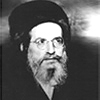 Baal HaSulam is the greatest Kabbalist of our time. It is very difficult to speak of such a tremendous force because we do not really understand what it means to be a Kabbalist. He lives alongside us and at the same time in a different world. A Kabbalist actually lives in two worlds.
Baal HaSulam is the greatest Kabbalist of our time. It is very difficult to speak of such a tremendous force because we do not really understand what it means to be a Kabbalist. He lives alongside us and at the same time in a different world. A Kabbalist actually lives in two worlds.
For a Kabbalist there is no confusion. He sees the upper world and the lower world. But what interests him most is their interdependence: how it is possible to make corrections in the upper world from the lower world such that it again influences the lower world and our world rises to the level of the upper. This is the task of every Kabbalist.
A Kabbalist is coming from that desire which characterizes him in the general system of the soul called “Adam.” Each of us has a different root. It is called “point of reference” or “point in the heart.” And that’s why each reveals the upper world in their own unique way.
However, all points in the heart reveal this system in a relatively similar fashion. Nonetheless, all those who wrote prior to Baal HaSulam, for example, had a very difficult time writing a commentary to The Book of Zohar.
And prior to the appearance of The Book of Zohar, no one was able to write anything even resembling it, despite the fact that many Kabbalists knew more than Rabbi Shimon. They just couldn’t describe it the way he could.
That is, in Kabbalah there are many such conditions: you can be great, a spiritual genius, but cannot describe anything, you simply don’t have the ability.
But Baal HaSulam had both of these qualities. It’s amazing! In the entire history of Kabbalah there was practically no Kabbalist with such ability.
Moses was the greatest Kabbalist, and still the Five Books written by him are written in such a way and in such language that everyone can interpret them in any way they want.
And what was written by the Ari in his work The Tree of Life cannot be understood at all; here, a clear attainment of the spiritual world is necessary for one to even begin to understand what he is talking about. In this book, purely physical data are laid out, just as in any physics textbook.
That’s why when the Ari started to teach, the only one who was able to appreciate him was a great Kabbalist of his own time, the Ramak. He sent all the other students to the Ari as well, emphasizing that this material is something new. But neither they, nor he, were able to understand the system of the Ari, not even to the day he died. And that’s because the Ramak belonged to the previous generation of souls, those who came into this world prior to the Ari.
That’s why Baal HaSulam openly says: “All that I attained, I attained following the Ari’s soul incarnating in me,” in other words, he was the Ari’s next incarnation. What is meant here is not the physical body, since it doesn’t exist and neither does our world. The only thing that exists is the shattered, scattered desire in a tremendous egoistic space.
In this space there are drops, like raisins in a cake that have inclinations toward unity, toward adhesion with the Creator. But we don’t feel these inclinations because we exist in an ocean of egoism, we sit in this dough, that’s why we don’t even sense our ego. Each “raisin,” each point in the heart, constantly undergoes all types of corrections.
Baal HaSulam happens to have been the outcome of that same “raisin,” which was the Ari, that same soul who was the Ari, who continued his work. This is called an “incarnation.” In other words, this is not a separate soul, but that same soul continuing its work, only under different conditions, in a different generation.
And what does a “generation” mean? It is not what happens to us in our world. When many points in the heart, embryos of a soul, even though they are changing constantly, while they still exist in a wrong kind of connection between them, they imagine themselves ostensibly experiencing our world.
That’s why it is most important that we think not of this world, presenting itself to us through our five animal sensory systems, but instead about that which is happening through the point in the heart.
Question: When a soul reincarnates, is the individuality preserved?
Answer: The soul engages through various external conditions. The Ari brought into our world The Tree of Life. The next time that same Ari came, he was called Baal HaSulam and brought into our lives Talmud Eser Sefirot.
Question: In other words, he held the same spiritual level of attainment as the Ari?
Answer: Even greater.
[214143]
From the Lesson in Russian, 10/16/16
[214143]
From the Lesson in Russian, 10/16/16

No comments:
Post a Comment